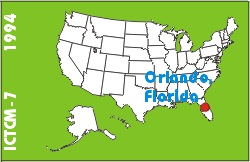
Electronic Proceedings of the Seventh Annual International Conference on Technology in Collegiate MathematicsOrlando, Florida, November 17-20, 1994Paper C031Using Spreadsheets and DERIVE to Teach Differential Equations |
Kathleen ShannonDepartment of Mathematics and Computer Science Salisbury State University Salisbury, MD 21801 USA Phone: (410)543-6476 Fax: (410)543-3313 KMSHANNON@SAE.SSU.UMD.EDU |
| Click to access this paper: |
ABSTRACT
Spreadsheets, although initially designed for business applications have found recent popularity in mathematics. In the past it has been difficult, if not impossible, to do much in a one semester Differential Equations course with classical methods of approximating solutions. Calculating fourth order Runge-Kutta approximations with a calculator is so tedious that it is rarely instructive. Students feel no sense of accomplishment when they get a numerical result they find difficult to interpret. However, with a spreadsheet program students can easily, without advance computer experience learn how to set up any explicit finite difference approximation, graph the result, experiment with different step sizes and compare to an analytic solution.Another sticking point in the first semester Differential Equations course are solutions expressed in terms of definite integrals which must be approximated. Students do not believe that, for example, when asked to solve the initial value problem:
y'' - y = 1/x; y(1) = 0 y'(1) = -2that
y(x) = e^(1-x) - e^(x-1)
+ e^x Integral from 1 to x e^(-t)/t dt
- e^-x Integral from 1 to x e^t/t dt
is an acceptable answer and every bit as legitimate a function of x as sin(x).
However, even a relatively simple to learn computer algebra package like
DERIVE can graph functions defined this way. In this instance, a picture is
truly worth a thousand words. students who see a graph of this function are
much more inclined to believe than ones who are shown how to use Simpson's rule
to compute a few values. In fact, using DERIVE they can do both.
In this paper directions for programming a spreadsheet to approximate solutions to first order differential equations will be given and their efficacy in teaching will be discussed. Also use of DERIVE to graph direction fields, to approximate solutions, to graph functions defined by definite integrals and to help with tedious algebra will be discussed.
Keyword(s): Derive, differential equations, spreadsheets
